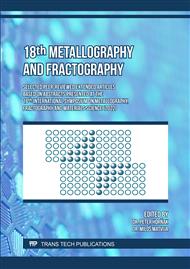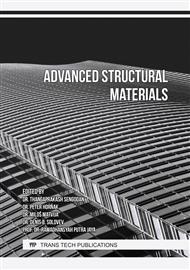[1]
A. Gogia, High-temperature titanium alloys, Defence Science Journal. 55(2) (2005) 149-173.
Google Scholar
[2]
E. Dong, W. Yu, Q. Cai, L. Cheng, and J. Shi, High-Temperature Oxidation Kinetics and Behavior of Ti–6Al–4V Alloy, Oxid. Met. 88, (2017) 719–732.
DOI: 10.1007/s11085-017-9770-0
Google Scholar
[3]
C. Oskay, M. Haney, Computational modelling of titanium structures subjected to thermo-chemo-mechanical environment, Int. J. of Solids and Structures. 47 (2010) 3341-3351.
DOI: 10.1016/j.ijsolstr.2010.08.014
Google Scholar
[4]
P. Seth, J.S. Jha, A. Alankar, S.K. Mishra, Alpha-case formation in Ti-6Al-4V in a different oxidizing environment and its effect on tensile and fatigue crack growth behaviour, Oxid. of Metals. 97 (2022) 77-95.
DOI: 10.1007/s11085-021-10079-y
Google Scholar
[5]
A. M. Bauristhene, K. Mutombo, W.E. Stumpf, Alpha case formation mechanism in Ti-6Al-4V alloy investment castings using YFSZ shell moulds, The Journal of The SAIMM. 113 (2013) 357-361.
Google Scholar
[6]
W. J. Boettinger, M. E. Williams, S. R. Coriell, U. R. Kattner, and B.A. Mueller, Alpha Case Thickness Modeling in Investment Castings, Metallurgical and Materials Transactions B. 31B (2000) 1419-1427.
DOI: 10.1007/s11663-000-0026-y
Google Scholar
[7]
D. Rugg, Environmental Behavior of Titanium Alloys - Threats, Mechanisms and Knowledge Gaps, in: V. Venkatesh, et al. (Eds.), Proceedings of the 13th World Conference on Titanium, The Minerals, Metals & Materials Society (TMS), 2016, pp.1475-1481.
DOI: 10.1002/9781119296126.ch248
Google Scholar
[8]
K. S. Chan, M. Koike, B.W. Johnson, T. Okabe, Modeling of Alpha-Case Formation and Its Effects on the Mechanical Properties of Titanium Alloy Castings, Metal. and Mater. Trans. A. 39A (2008) 171-180.
DOI: 10.1007/s11661-007-9406-0
Google Scholar
[9]
X. Feng, Y. Liang, H. Sun, S. Wang, Effect of Dislocation Slip Mechanism under the Control of Oxygen Concentration in Alpha-Case on Strength and Ductility of TC4 Alloy, Metals. 11 (2021) 1057.
DOI: 10.3390/met11071057
Google Scholar
[10]
E. Dong, W. Yu, Q. Cai, Alpha-case kinetics and high-temperature plasticity of Ti-6Al-4V alloy oxidized in different phase regions, Procedia Engineering. 207 (2017) 2149-2154.
DOI: 10.1016/j.proeng.2017.10.973
Google Scholar
[11]
D. Texier, Q. Sirvin, V. Velay, M. Salem, D. Monceau, B. Mazères, E. Andrieu, R. Roumiguier, B. Dod, Oxygen/nitrogen-assisted embrittlement of titanium alloys exposed at elevated temperature, in: The 14th World Conference on Titanium (Ti 2019) MATEC Web of Conferences. 321, 2020, 06004.
DOI: 10.1051/matecconf/202032106004
Google Scholar
[12]
J. S. Jha, S. Dhala, S. P. Toppo, R. Singh, A. Tewari, S. K. Mishra, B. Jayabalan, Effect of strain amplitude on low cycle fatigue and microstructure evolution in Ti-6Al-4V: A TKD and TEM characterization, Materials Characterization. 155 (2019) 109829.
DOI: 10.1016/j.matchar.2019.109829
Google Scholar
[13]
P. D. Littlewood, A.J. Wilkinson, Local deformation patterns in Ti–6Al–4V under tensile, fatigue and dwell fatigue loading, International Journal of Fatigue. 43 (2012) 111–119.
DOI: 10.1016/j.ijfatigue.2012.03.001
Google Scholar
[14]
J. Belan, L. Kuchariková, E. Tillová, M. Chalupová, Three-Point Bending Fatigue Test of TiAl6V4 Titanium Alloy at Room Temperature, in: D. Rozumek, A. Balitskii, G. Lesiuk, S. Seitl (Eds.), Cumulation of Failure and Crack Growth in Materials, Hindawi, 2019, pp.1-11.
DOI: 10.1155/2019/2842416
Google Scholar
[15]
G. Q. Wu, C. L. Shi, W. Sha, A. X. Sha, H. R. Jiang, Effect of microstructure on the fatigue properties of Ti–6Al–4V titanium alloys, Materials & Design. 46 (2013) 668-674.
DOI: 10.1016/j.matdes.2012.10.059
Google Scholar
[16]
Ch. Buirette, J. Huez, N. Gey, A. Vassel, E. Andrieu, Study of crack propagation mechanisms during Charpy impact toughness tests on both equiaxed and lamellar microstructures of Ti–6Al–4V titanium alloy, Materials Science & Engineering A. 618 (2014) 546–557.
DOI: 10.1016/j.msea.2014.09.048
Google Scholar



